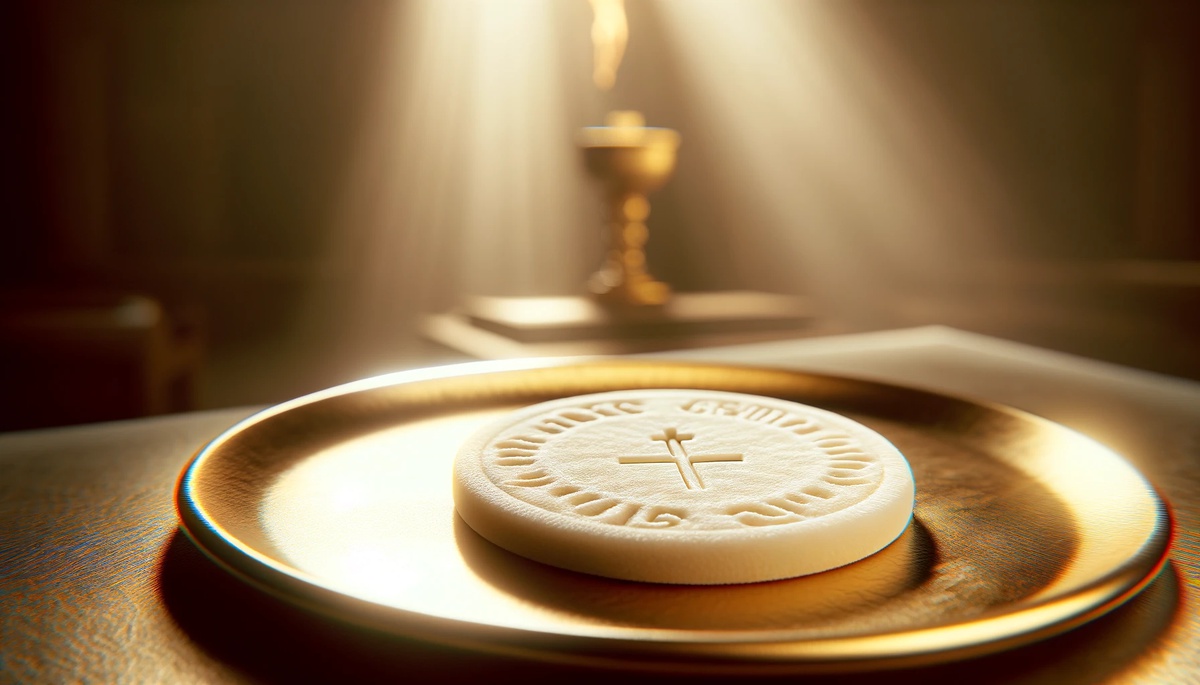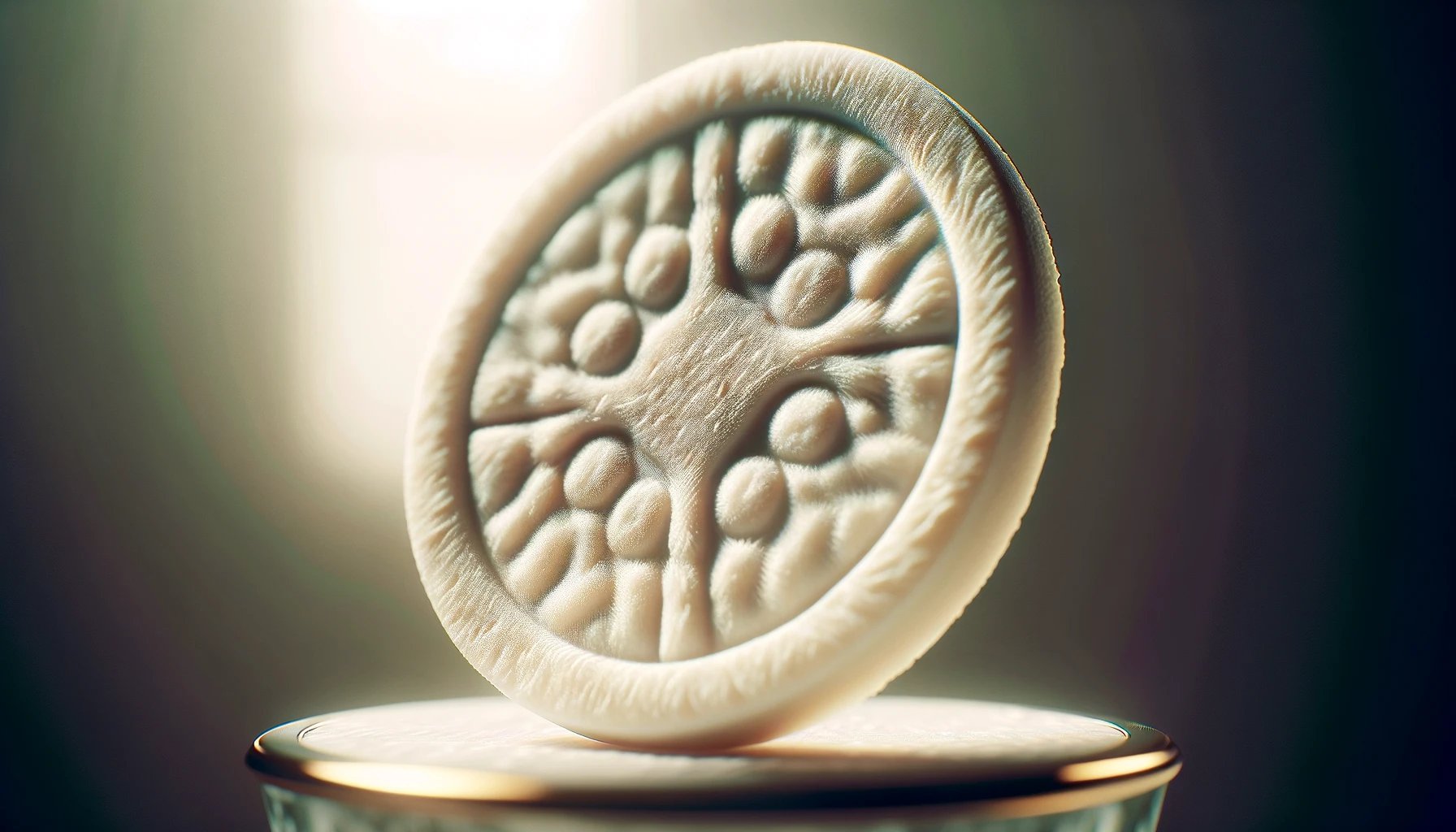Home>Theology and Spirituality>What Is Communion Rite


Theology and Spirituality
What Is Communion Rite
Published: February 19, 2024
Jason DeRose, Managing Editor at Christian.net, uses his expertise in religion and journalism to deepen understanding of faith's societal impacts. His editorial leadership, coupled with a strong academic background, enriches the platform’s diverse content, earning him recognition in both journalism and religious circles.
Learn about the theology and spirituality behind the Communion Rite. Explore the significance and practices of this sacred ritual.
(Many of the links in this article redirect to a specific reviewed product. Your purchase of these products through affiliate links helps to generate commission for Christian.net, at no extra cost. Learn more)
Table of Contents
Introduction
The Communion Rite, also known as the Eucharist or Holy Communion, holds a central place in Christian worship and theology. It is a sacred ritual that symbolizes the core beliefs of the Christian faith and serves as a profound spiritual practice for millions of believers worldwide. This ancient tradition, rooted in the teachings of Jesus Christ, continues to be a source of deep significance and reverence for Christians across denominations.
The Communion Rite is a poignant reenactment of the Last Supper, a pivotal event in the life of Jesus as recorded in the New Testament. During this final meal with his disciples, Jesus instituted the practice of sharing bread and wine as symbols of his body and blood, establishing a profound spiritual connection between himself and his followers. This act of sharing in the elements of bread and wine has been perpetuated through the ages as a means of commemorating Jesus' sacrificial death and celebrating the spiritual nourishment and unity it represents.
As a fundamental aspect of Christian worship, the Communion Rite fosters a sense of community and spiritual communion among believers. It serves as a tangible expression of the shared faith and fellowship that unites Christians around the world. The act of partaking in the bread and wine signifies a profound spiritual union with Christ and fellow believers, transcending individual identity and emphasizing the interconnectedness of the Christian community.
The Communion Rite also embodies the concept of remembrance and anticipation within Christian theology. It is a remembrance of Jesus' sacrificial death and a celebration of the redemptive power of his resurrection. Additionally, it serves as an anticipation of the future fulfillment of God's kingdom, emphasizing the hope and expectation of Christ's return as central to the Christian faith.
In the subsequent sections of this article, we will delve deeper into the definition, history, significance, and diverse expressions of the Communion Rite within various Christian traditions. By exploring these facets, we can gain a richer understanding of the profound spiritual and theological dimensions of this sacred practice.
Read more: What Happens During The Communion Rite
Definition of Communion Rite
The Communion Rite, also known as the Eucharist or Holy Communion, is a sacred sacrament in Christian worship that symbolizes the central beliefs of the Christian faith. At its core, the Communion Rite is a profound spiritual practice that commemorates the Last Supper, a significant event in the life of Jesus Christ. This ritual involves the sharing of bread and wine, which are regarded as symbols of Christ's body and blood, among the participants. Through this act, believers seek to experience a deep spiritual connection with Jesus and with one another, emphasizing the fundamental principles of unity, remembrance, and anticipation within the Christian tradition.
The Communion Rite is deeply rooted in the teachings and actions of Jesus Christ, as documented in the New Testament. During the Last Supper, Jesus shared bread and wine with his disciples, instructing them to partake in these elements as a means of remembering him. He imbued these simple yet profound symbols with deep spiritual significance, declaring that the bread represented his body, which would be given for them, and the wine symbolized his blood, which would be shed for the forgiveness of sins. This act of sharing in the bread and wine was an embodiment of the sacrificial nature of Jesus' impending death and a testament to the spiritual nourishment and unity it would bring to his followers.
The Communion Rite is regarded as a sacred and solemn practice within Christian worship, representing the spiritual sustenance and unity that believers find in their relationship with Christ and with one another. It serves as a tangible expression of the shared faith and fellowship that binds Christians together across diverse denominations and cultural contexts. Through the act of partaking in the bread and wine, participants express their commitment to the teachings of Jesus and their identification with the Christian community, transcending individual differences and emphasizing the interconnectedness of the body of Christ.
In essence, the Communion Rite is a multifaceted ritual that encapsulates the foundational elements of Christian faith, including remembrance, spiritual nourishment, unity, and anticipation. It stands as a timeless symbol of the enduring significance of Jesus' life, death, and resurrection, inviting believers to partake in a sacred communion that transcends the boundaries of time and space, uniting them with Christ and with one another in a profound and transformative manner.
History of Communion Rite
The history of the Communion Rite can be traced back to the Last Supper, a pivotal event in the life of Jesus Christ as depicted in the New Testament. It was during this final meal with his disciples that Jesus instituted the practice of sharing bread and wine as symbols of his body and blood. This act holds profound significance in the Christian faith and serves as the foundational event from which the Communion Rite emerged.
The accounts in the Gospels of Matthew, Mark, and Luke, as well as the writings of the apostle Paul in the New Testament, provide insights into the origins of the Communion Rite. These scriptures describe how Jesus, while sharing the Passover meal with his disciples, took bread, blessed it, broke it, and gave it to them, saying, "Take, eat; this is my body." He then took the cup, gave thanks, and gave it to them, saying, "Drink from it, all of you; for this is my blood of the covenant, which is poured out for many for the forgiveness of sins."
Following this significant event, the early Christian communities continued the practice of sharing bread and wine as a means of commemorating Jesus' sacrificial death and celebrating the spiritual nourishment and unity it represents. This practice became an integral part of Christian worship, symbolizing the believers' participation in the body and blood of Christ and their unity as a community of faith.
Over the centuries, the Communion Rite evolved within different Christian traditions, acquiring diverse liturgical expressions and theological interpretations. The early church fathers, such as Ignatius of Antioch and Justin Martyr, provided insights into the early Christian understanding of the Eucharist, emphasizing its central role in the life of the church and its significance as a means of spiritual sustenance and unity.
The Communion Rite continued to be a focal point of Christian worship throughout the medieval period and into the era of the Protestant Reformation. The theological debates surrounding the nature of the Eucharist, including the concepts of transubstantiation, consubstantiation, and memorialism, contributed to the rich tapestry of interpretations surrounding this sacred sacrament.
Today, the history of the Communion Rite is reflected in the diverse practices and theological perspectives found within various Christian denominations. Despite these differences, the central significance of the Communion Rite as a commemoration of Jesus' sacrificial death and a celebration of spiritual nourishment and unity remains a unifying factor across the global Christian community.
Significance of Communion Rite
The Communion Rite holds profound significance within the Christian faith, encompassing a rich tapestry of spiritual, theological, and communal implications. At its core, the Communion Rite serves as a poignant symbol of remembrance, spiritual nourishment, unity, and anticipation, embodying the foundational tenets of Christian belief and practice.
First and foremost, the Communion Rite serves as a powerful act of remembrance within Christian worship. It commemorates the sacrificial death of Jesus Christ and celebrates the redemptive significance of his resurrection. By partaking in the bread and wine, believers engage in a profound act of remembrance, recalling the selfless love and ultimate sacrifice of Jesus on the cross. This remembrance serves as a focal point of gratitude and reverence, reminding participants of the transformative power of Christ's atoning work and the eternal hope it brings to the Christian faith.
Furthermore, the Communion Rite embodies the concept of spiritual nourishment within the Christian tradition. It symbolizes the spiritual sustenance that believers receive through their relationship with Christ. The act of partaking in the bread and wine signifies a deep communion with Jesus, acknowledging his presence in the midst of the gathered community. This spiritual nourishment fosters a sense of inner renewal and sustenance, strengthening the faith of participants and reaffirming their connection to the living Christ.
Unity stands as another pivotal aspect of the Communion Rite's significance. As believers partake in the elements of bread and wine, they express their unity with Christ and with one another. The act of sharing in the Communion Rite transcends individual identity, emphasizing the interconnectedness of the Christian community. It serves as a tangible expression of the shared faith and fellowship that binds believers together, fostering a sense of communal solidarity and mutual support within the body of Christ.
Moreover, the Communion Rite carries a profound sense of anticipation within Christian theology. It serves as a foretaste of the future fulfillment of God's kingdom, emphasizing the hope and expectation of Christ's return. By participating in the Communion Rite, believers express their longing for the ultimate consummation of God's redemptive plan, looking forward to the day when they will partake in the heavenly banquet in the presence of the risen Christ.
In essence, the Communion Rite's significance extends far beyond a mere ritualistic practice; it encapsulates the core principles of Christian faith, serving as a powerful symbol of remembrance, spiritual nourishment, unity, and anticipation. This sacred sacrament continues to resonate deeply within the hearts of believers, offering a profound and transformative experience that transcends time and space, uniting them with Christ and with one another in a timeless communion of faith and hope.
Elements of Communion Rite
The Communion Rite encompasses several essential elements that collectively contribute to its profound significance within the Christian tradition. These elements, deeply rooted in the teachings and actions of Jesus Christ, serve as foundational pillars of the sacred sacrament, embodying the spiritual, theological, and communal dimensions of the Eucharistic celebration.
Read more: What Is The Essential Rite Of Baptism
1. Bread and Wine
At the heart of the Communion Rite are the elements of bread and wine, which hold profound symbolic significance within Christian theology. The bread, representing the body of Christ, and the wine, symbolizing his blood, are central to the commemoration of Jesus' sacrificial death and the spiritual nourishment it provides to believers. These elements serve as tangible symbols of Christ's presence and redemptive work, inviting participants to partake in a sacred communion with the living Christ.
2. Remembrance
The act of partaking in the bread and wine during the Communion Rite serves as a powerful act of remembrance, recalling the selfless love and ultimate sacrifice of Jesus on the cross. It invites participants to reflect on the redemptive significance of Christ's death and resurrection, fostering a deep sense of gratitude and reverence for the transformative power of his atoning work. This element of remembrance stands as a focal point of the Communion Rite, emphasizing the enduring impact of Jesus' life and teachings on the Christian faith.
3. Spiritual Nourishment
The Communion Rite symbolizes the spiritual sustenance that believers receive through their relationship with Christ. By partaking in the bread and wine, participants acknowledge their communion with Jesus, experiencing a profound sense of inner renewal and sustenance. This element of spiritual nourishment underscores the transformative impact of the Eucharistic celebration, strengthening the faith of believers and reaffirming their connection to the living Christ.
4. Unity
Central to the Communion Rite is the element of unity, which emphasizes the interconnectedness of the Christian community. As believers partake in the bread and wine, they express their unity with Christ and with one another, transcending individual identity and fostering a sense of communal solidarity. This element underscores the shared faith and fellowship that binds believers together, promoting mutual support and a deep sense of belonging within the body of Christ.
Read more: What Is A Communion For A Child
5. Anticipation
The Communion Rite carries a profound sense of anticipation, serving as a foretaste of the future fulfillment of God's kingdom. Participants express their longing for the ultimate consummation of God's redemptive plan, looking forward to the day when they will partake in the heavenly banquet in the presence of the risen Christ. This element of anticipation underscores the hope and expectation of Christ's return, infusing the Eucharistic celebration with a profound sense of eschatological significance.
In essence, the elements of the Communion Rite collectively embody the core principles of Christian faith, offering participants a transformative experience that transcends time and space. Through the symbolic elements of bread and wine, the act of remembrance, spiritual nourishment, unity, and anticipation, the Communion Rite stands as a timeless symbol of the enduring significance of Jesus' life, death, and resurrection, inviting believers to partake in a sacred communion that unites them with Christ and with one another in a profound and transformative manner.
Communion Rite in Different Christian Traditions
The Communion Rite, known by various names such as the Eucharist, Holy Communion, or the Lord's Supper, is a central sacrament in Christian worship, observed with diverse liturgical expressions and theological interpretations across different Christian traditions. The rich tapestry of beliefs and practices surrounding the Communion Rite reflects the theological diversity and historical developments within Christianity, offering a glimpse into the multifaceted nature of this sacred sacrament.
In the Roman Catholic tradition, the Communion Rite is deeply rooted in the concept of transubstantiation, wherein the bread and wine are believed to undergo a substantial change, becoming the actual body and blood of Christ while retaining the appearance of bread and wine. This understanding emphasizes the real presence of Christ in the Eucharistic elements and underscores the sacred nature of the Communion Rite as a means of encountering the living Christ in a tangible manner.
Within the Eastern Orthodox tradition, the Communion Rite, known as the Divine Liturgy, holds a central place in the liturgical life of the church. The Eucharistic celebration is characterized by intricate liturgical prayers, hymns, and symbolic gestures, reflecting the rich theological heritage of the Eastern Orthodox Church. The emphasis on mystery, reverence, and the participation in the divine life of Christ permeates the Eucharistic theology of the Eastern Orthodox tradition, shaping the spiritual experience of the Communion Rite for adherents.
In Protestant traditions, including Lutheran, Reformed, Anglican, and Methodist denominations, diverse theological perspectives on the Communion Rite have emerged, contributing to a spectrum of liturgical practices and beliefs. While Lutherans affirm the real presence of Christ in the Eucharistic elements, Reformed traditions emphasize the commemorative aspect of the Lord's Supper, focusing on the spiritual remembrance of Christ's sacrifice. Anglican and Methodist traditions encompass a range of theological interpretations, reflecting the diversity of beliefs within these denominations.
Furthermore, within the evangelical and charismatic traditions, the Communion Rite is observed with varying degrees of formality and theological emphasis, often reflecting the influence of individual church doctrines and practices. The celebration of the Eucharist in these traditions may encompass a spectrum of theological perspectives, ranging from a focus on personal spiritual communion with Christ to a symbolic remembrance of his sacrificial death.
In essence, the Communion Rite in different Christian traditions reflects the theological diversity and historical developments within Christianity, encompassing a spectrum of liturgical expressions and theological interpretations. While the core elements of the Eucharistic celebration remain consistent across traditions, the nuanced beliefs and practices surrounding the Communion Rite serve as a testament to the richness and complexity of the Christian faith as expressed through diverse cultural, theological, and ecclesiastical contexts.
Conclusion
The Communion Rite, also known as the Eucharist or Holy Communion, stands as a timeless symbol of the enduring significance of Jesus' life, death, and resurrection within the Christian faith. This sacred sacrament embodies the core principles of remembrance, spiritual nourishment, unity, and anticipation, inviting believers to partake in a sacred communion that unites them with Christ and with one another in a profound and transformative manner.
Throughout history, the Communion Rite has served as a focal point of Christian worship, rooted in the teachings and actions of Jesus Christ as recorded in the New Testament. The Last Supper, a pivotal event in the life of Jesus, marked the institution of the Communion Rite, where he shared bread and wine with his disciples, imbuing these elements with deep spiritual significance. This act of sharing in the bread and wine symbolized Jesus' sacrificial death and the spiritual nourishment and unity it would bring to his followers.
The significance of the Communion Rite extends far beyond a mere ritualistic practice; it serves as a powerful symbol of remembrance, spiritual nourishment, unity, and anticipation. As participants partake in the bread and wine, they engage in a profound act of remembrance, reflecting on the redemptive significance of Christ's atoning work and expressing gratitude for his selfless love. The Communion Rite also symbolizes the spiritual sustenance that believers receive through their relationship with Christ, fostering a deep sense of inner renewal and sustenance. Moreover, it emphasizes the interconnectedness of the Christian community, transcending individual identity and fostering a sense of communal solidarity.
The diverse expressions of the Communion Rite within various Christian traditions reflect the theological diversity and historical developments within Christianity. From the Roman Catholic emphasis on transubstantiation to the intricate liturgical prayers of the Eastern Orthodox tradition and the diverse theological perspectives within Protestant denominations, the Communion Rite encompasses a spectrum of liturgical expressions and theological interpretations, enriching the spiritual tapestry of the global Christian community.
In conclusion, the Communion Rite stands as a profound and transformative practice that continues to resonate deeply within the hearts of believers, offering a timeless symbol of the enduring significance of Jesus' life, death, and resurrection. It serves as a sacred communion that unites believers with Christ and with one another, fostering a sense of spiritual nourishment, unity, and anticipation within the Christian faith.













